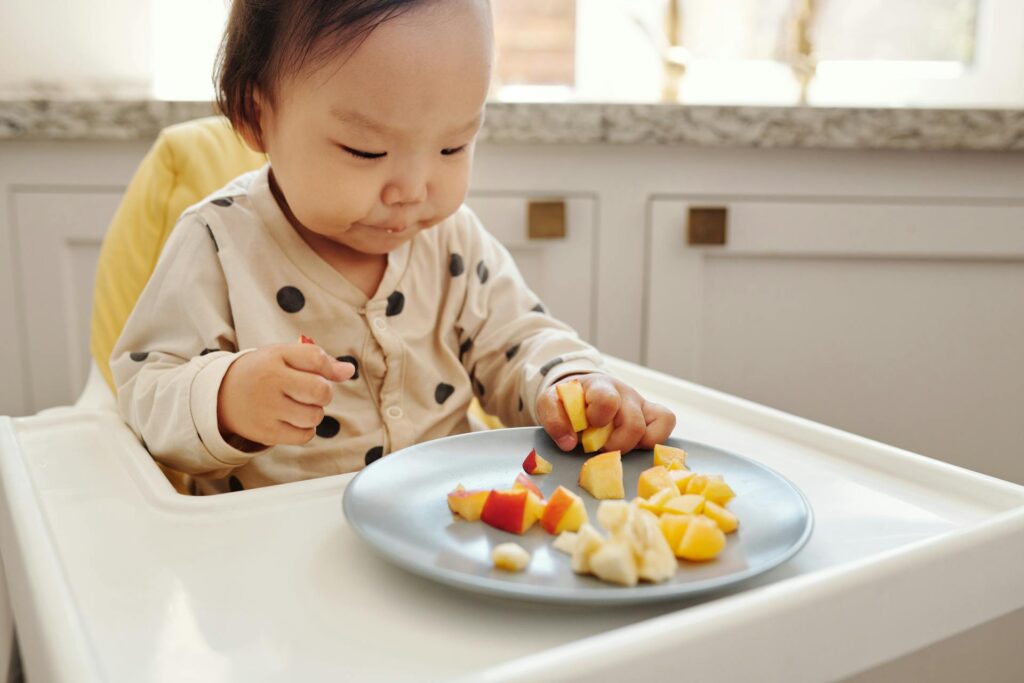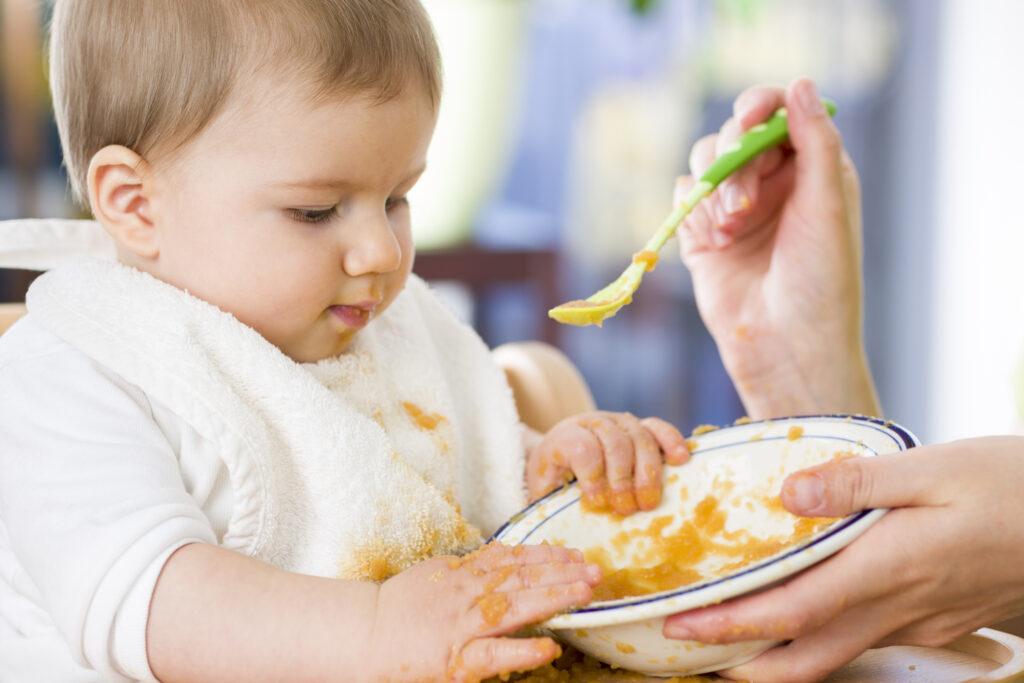Introducing solids is a huge milestone in your baby’s development, but with so many different approaches, it can feel overwhelming for parents. The two most common methods are baby-led weaning vs. traditional weaning, each offering unique benefits and challenges. But which approach is best for your baby?
Weaning marks a transition from exclusive milk feeding to solid foods, helping babies learn new textures, flavors, and self-feeding skills. Some parents prefer baby-led weaning (BLW), where babies explore solid foods on their own, while others opt for traditional spoon-feeding, ensuring controlled portions and a smoother transition.
Studies suggest that early feeding experiences shape long-term eating habits (AAP), making it essential for parents to choose a method that aligns with their baby’s developmental readiness and family lifestyle.
In this guide, we’ll break down:
- The key differences between baby-led weaning and spoon-feeding.
- The benefits and challenges of each method.
- Safety tips and best practices to ensure a smooth transition.
- How to combine both methods for a flexible approach.
By the end, you’ll have a clear understanding of which weaning approach best suits your baby and how to make the transition nutritionally balanced, safe, and enjoyable!
What is Baby-Led Weaning (BLW)?

Baby-led weaning (BLW) is an approach where babies skip purees and spoon-feeding and instead start eating soft, whole foods that they can pick up and feed themselves. This method promotes self-regulation, motor skill development, and early sensory exploration.
Unlike traditional weaning, where parents control portion sizes and feeding schedules, BLW encourages babies to explore foods at their own pace, fostering a positive relationship with food from an early age.
Key Features of Baby-Led Weaning:
- No purees or spoon-feeding – Babies eat soft, whole foods they can grasp.
- Self-feeding from the start – Encourages independence and motor skill development.
- Family meals together – Babies eat modified versions of family foods instead of separate meals.
- Baby sets the pace – They decide how much to eat based on hunger cues.
📝 According to a study published in the Journal of Human Nutrition and Dietetics, babies who follow baby-led weaning are more likely to develop healthier eating habits and have lower risks of obesity later in life.
Benefits of Baby-Led Weaning
1️⃣ Encourages Independence & Self-Regulation
BLW allows babies to listen to their hunger cues rather than being spoon-fed a set amount. This reduces the risk of overeating and helps establish healthy eating habits early on.
2️⃣ Supports Fine Motor Skills & Hand-Eye Coordination
Picking up different textures and shapes helps strengthen finger grasp and coordination, preparing babies for utensil use and self-feeding as they grow.
3️⃣ Involves Babies in Family Mealtimes
Since BLW encourages babies to eat what the family eats, they feel included, leading to positive mealtime experiences and social development.
4️⃣ May Reduce Picky Eating
Exposure to a variety of textures, colors, and flavors early on can lead to greater food acceptance and less picky eating as they grow.
📝 The World Health Organization (WHO) states that early exposure to diverse flavors and textures may reduce food neophobia (fear of new foods) in toddlers.
Challenges & Considerations of Baby-Led Weaning
- Messier Mealtimes – Self-feeding is messier compared to spoon-feeding, requiring patience and cleanup.
- Choking Concerns – Proper food preparation (e.g., soft textures, small bite-sized pieces) is essential to reduce risks.
- Ensuring Nutrient Intake – Babies may not consume enough iron-rich foods if not monitored.
📝 The American Academy of Pediatrics (AAP) recommends supplementing with iron-rich foods like mashed beans, eggs, and soft-cooked meats to ensure proper nutrition during BLW.
Is Baby-Led Weaning Right for Your Baby?
BLW works best for babies who:
- Show signs of readiness (can sit up unassisted, bring food to their mouth, and show interest in food).
- Have good hand coordination to grasp and explore food.
- Are not at high risk for swallowing difficulties (check with a pediatrician if unsure).
For parents who prefer less mess or more control over food intake, traditional spoon-feeding may be a better option. However, many families successfully combine both methods for flexibility!
What is Traditional Weaning (Spoon-Feeding)?
Traditional weaning (also called spoon-feeding or parent-led weaning) follows a structured approach, where babies start with smooth purees before transitioning to mashed and solid foods over time. Caregivers control portions and feeding pace, ensuring that the baby receives adequate nutrition.
This method is the most commonly recommended by pediatricians, especially for babies who may have developmental delays, prematurity, or feeding difficulties.
Key Features of Traditional Weaning:
- Reduces choking risks – Purees and mashed foods are easier to swallow and digest.
- Introduction of solids in stages – Babies start with purees and gradually progress to mashed and solid textures.
- Parental control over food intake – Parents decide what, when, and how much the baby eats.
- Ensures nutritional intake – Spoon-feeding helps parents monitor if the baby is getting enough iron, protein, and essential nutrients.

📝 According to the American Academy of Pediatrics (AAP), traditional spoon-feeding ensures a smooth transition from milk to solids, especially for babies who may not yet have strong chewing skills.
Benefits of Traditional Weaning
1️⃣ Easier to Monitor Nutritional Intake
Spoon-feeding allows parents to control portion sizes, ensuring that the baby receives enough iron, protein, and essential vitamins needed for growth.
2️⃣ Less Choking Risk
Since parents control the texture and consistency of the food, the risk of choking is lower compared to baby-led weaning.
3️⃣ Good for Premature or Developmentally Delayed Babies
Babies born prematurely or those with oral motor delays may struggle with self-feeding early on. Spoon-feeding allows for a gentler transition to solids.
📝 A study in the Journal of Pediatrics found that premature infants who followed traditional spoon-feeding had a higher likelihood of meeting their nutritional requirements by 9 months.
4️⃣ Less Mess at Mealtime
Since parents are in control of feeding, meals tend to be cleaner and more structured, compared to baby-led weaning where food is often explored hands-on.
Challenges & Considerations of Traditional Weaning
- Less Sensory Exploration – Babies may take longer to adjust to different food textures.
- Potential for Food Refusal Later – If babies are not exposed to self-feeding, they may develop pickier eating habits later on.
- Requires More Parent Involvement – Spoon-feeding means parents need to be actively feeding during meals, requiring more effort than BLW.
📝 According to the World Health Organization (WHO), introducing a variety of textures before 9 months helps reduce the likelihood of food refusal in toddlers.
Is Traditional Weaning Right for Your Baby?
Traditional spoon-feeding works best for babies who:
- Prefer a structured, gradual transition to solid foods.
- Have strong sucking reflexes but are not yet ready for self-feeding.
- Were born prematurely or have developmental delays that require careful feeding monitoring.
Parents who want less mess and more control over feeding may find this method easier to manage. However, many families choose to introduce self-feeding alongside spoon-feeding, creating a hybrid approach.
Baby-Led Weaning vs. Traditional Weaning – Key Differences
Now that we’ve explored both weaning approaches, let’s compare baby-led weaning vs. traditional weaning side by side. Each method has its own strengths, challenges, and suitability based on your baby’s needs and family lifestyle.
1️⃣ Feeding Style: Who’s in Control?
🔹 Baby-Led Weaning (BLW): Babies are in full control of what and how much they eat. They pick up soft finger foods and self-feed, setting their own pace.
🔹 Traditional Weaning: Parents control spoon-feeding, deciding the portion sizes and ensuring that the baby eats a variety of foods.
📝 According to the American Academy of Pediatrics (AAP), allowing babies to self-feed can help improve self-regulation and reduce overeating habits later in life.
2️⃣ Nutritional Intake & Iron Absorption
🔹 BLW: Babies may not always consume enough iron-rich foods, as they tend to eat smaller portions.
🔹 Traditional Weaning: Spoon-feeding ensures iron-fortified cereals, purees, and protein-rich foods are included in a baby’s diet.
📝 A study in the Journal of Pediatric Gastroenterology & Nutrition found that babies who follow traditional spoon-feeding are more likely to meet their daily iron requirements.
3️⃣ Development of Motor Skills
🔹 BLW: Encourages fine motor skills, hand-eye coordination, and early utensil use. Babies learn to grasp, chew, and explore textures sooner.
🔹 Traditional Weaning: Motor skills develop later, as parents control feeding. Babies may take longer to transition to finger foods.
📝 The World Health Organization (WHO) states that introducing finger foods between 6-9 months helps strengthen oral-motor skills and chewing abilities.
4️⃣ Choking & Safety Considerations
🔹 BLW: Higher choking risks if food is not cut properly or if babies lack chewing experience. Parents must monitor closely and choose soft, appropriate foods.
🔹 Traditional Weaning: Lower choking risk as babies start with smooth purees and gradually transition to solids.
📝 The AAP recommends waiting until babies show readiness signs before starting solids, regardless of the weaning approach.
5️⃣ Risk of Picky Eating
🔹 BLW: Exposure to various textures and flavors may reduce picky eating tendencies. Babies develop a positive relationship with food early on.
🔹 Traditional Weaning: Spoon-fed babies may take longer to accept new textures, leading to potential food refusal later.
📝 A review in the Journal of the Academy of Nutrition and Dietetics suggests that early texture exposure through BLW may reduce food neophobia (fear of new foods) in toddlers.
Comparison Table: BLW vs. Traditional Weaning
| Factor | Baby-Led Weaning | Traditional Weaning |
|---|---|---|
| Who Controls Feeding? | Baby decides | Parent-led |
| Motor Skill Development | High – babies grasp & chew earlier | Develops later |
| Choking Risk | Higher if food is not cut properly | Lower due to purees |
| Mess Level | High – self-feeding is messy | Lower – spoon-fed meals are cleaner |
| Nutritional Monitoring | Harder to ensure adequate iron intake | Easier – parent controls diet |
| Picky Eating Prevention | May reduce food refusal | Can delay texture acceptance |
| Best for Premature Babies? | Can be difficult for preemies | Suitable for early feeding challenges |
Which Weaning Method is Right for Your Baby?
Choosing between baby-led weaning vs. traditional weaning depends on:
- Baby’s Readiness – Can they sit upright and grasp food?
- Parental Comfort – Are you okay with a messier but independent eating style, or do you prefer a structured approach?
- Nutritional Needs – Are you comfortable monitoring nutrient intake with BLW, or do you prefer the control of spoon-feeding?
Many parents choose a combination of both methods, allowing self-feeding for exploration while spoon-feeding for nutrition assurance.
Pro Tip: If unsure, consult your pediatrician or a registered dietitian to tailor a weaning plan that suits your baby’s growth and developmental needs.
Can You Combine Both Methods? (The Hybrid Approach)
If you’re feeling torn between baby-led weaning vs. traditional weaning, you’re not alone! Many parents opt for a hybrid approach, blending the best aspects of both methods to create a flexible, stress-free feeding experience.


A combination of BLW and spoon-feeding allows babies to explore self-feeding while still ensuring they receive essential nutrients. This method is particularly useful for parents who want to encourage independence but also monitor nutritional intake.
How the Hybrid Approach Works
- Begin with Traditional Weaning – Start with smooth purees to introduce new flavors, ensuring that babies get iron-rich foods from the beginning.
- Introduce Soft Finger Foods – Around 6-7 months, offer soft, easy-to-grasp foods (steamed veggies, banana, avocado) alongside spoon-fed meals.
- Allow Gradual Self-Feeding – Encourage babies to hold the spoon, dip into food, or grab pieces while still offering nutrient-dense purees.
- Increase Self-Feeding Over Time – As babies develop motor skills, allow more control over meals, offering a mix of purees and whole foods.
📝 According to the American Academy of Pediatrics (AAP), a mixed approach can help babies develop self-feeding skills while ensuring they meet their nutritional needs.
Benefits of Combining BLW & Spoon-Feeding
- Best of Both Worlds – Babies enjoy self-feeding while parents ensure proper nutrition.
- Easier Texture Transition – Gradual introduction to different textures helps prevent food refusal later.
- Reduces Choking Concerns – Parents can monitor food sizes and swallowing abilities while allowing self-exploration.
- Flexible for Different Feeding Situations – Works well whether at home or on the go, allowing for structured meals when needed.
📝 A study in the Journal of Pediatric Gastroenterology & Nutrition found that babies who were gradually introduced to solids through a hybrid approach showed greater food acceptance and reduced feeding difficulties.
What Does a Hybrid Weaning Meal Look Like?
A balanced hybrid approach includes:
🥄 Spoon-fed Nutrient-Dense Foods – Iron-fortified cereals, mashed beans, yogurt, or vegetable purees.
🍎 Soft Finger Foods – Avocado slices, steamed sweet potatoes, scrambled eggs, or banana pieces.
🖐 Baby Exploration – Letting the baby hold and taste different textures while still providing guided feeding.
This method allows babies to practice self-feeding in a safe, structured environment while ensuring they get nutrient-rich foods from the start.
Pro Tip: If your baby enjoys self-feeding, try pre-loading a spoon with puree and allowing them to bring it to their mouth, blending both methods seamlessly.
Who Should Consider the Hybrid Approach?
A mixed weaning method is great for:
- Parents who want to monitor nutritional intake but also encourage independence.
- Babies who struggle with texture transitions and need more time adjusting.
- Families looking for a less stressful, adaptable feeding routine.
If you’re unsure about fully committing to BLW or spoon-feeding, a hybrid approach provides flexibility while still supporting self-feeding skills.
Safety Tips for Introducing Solids
Regardless of whether you choose baby-led weaning vs. traditional weaning, safety should always come first when introducing solids. Proper food preparation, supervision, and awareness of choking hazards are essential to ensure that your baby’s transition to solids is smooth and risk-free.
1️⃣ Recognize Signs of Readiness

Before introducing solids, make sure your baby is developmentally ready. According to the American Academy of Pediatrics (AAP), babies should meet these key readiness signs before starting solids:
- Can sit up independently and hold their head steady.
- Shows interest in food, such as reaching for items or opening their mouth when food is offered.
- Can bring objects to their mouth and move food to the back of their tongue.
- Loses the tongue-thrust reflex, meaning they no longer automatically push food out of their mouth.
If your baby is not meeting these signs yet, it’s best to wait before introducing solids to prevent choking risks and ensure proper digestion.
2️⃣ Minimize Choking Hazards
Choking risks are higher when introducing solid foods, especially with baby-led weaning. Follow these best practices:
- Always supervise your baby while eating—never leave them alone with food.
- Avoid high-risk choking foods, such as whole grapes, nuts, popcorn, raw carrots, hot dogs, or chunks of meat.
- Cut food into safe sizes – For BLW, slice food into finger-length strips that are soft and easy to mash.
- Encourage proper sitting posture – Babies should eat while sitting upright, never reclined.
📝 According to the CDC, infants are at the highest choking risk between 6-12 months, making proper food preparation crucial when introducing solids.
3️⃣ Offer a Variety of Nutrient-Dense Foods
Whether using BLW or spoon-feeding, focus on iron-rich, high-nutrient foods to support your baby’s rapid growth and brain development.
- Iron Sources – Mashed beans, soft-cooked eggs, lentils, ground meats, iron-fortified cereals.
- Healthy Fats – Avocado, nut butters (thinly spread), full-fat dairy.
- Soft Fruits & Veggies – Steamed carrots, sweet potatoes, banana, ripe peaches.
📝 A study published in the Journal of Pediatrics suggests that introducing a variety of flavors and textures before 9 months helps reduce picky eating later in childhood.
4️⃣ Follow the “One New Food at a Time” Rule
When introducing solids, offer one new food every 3-5 days to monitor for allergic reactions. Symptoms of food allergies include:
- Rash, hives, or swelling around the mouth.
- Vomiting, diarrhea, or stomach upset.
- Wheezing or difficulty breathing.
📝 The American Academy of Allergy, Asthma & Immunology (AAAAI) recommends introducing common allergens early (such as eggs, peanuts, dairy) to reduce allergy risks, but always under medical guidance.
5️⃣ Avoid Adding Sugar & Salt
Babies’ kidneys are still developing, and excessive salt and sugar can be harmful. Avoid:
- Processed baby snacks with added sugar.
- Salty foods like chips, processed meats, or store-bought sauces.
- Honey (risk of botulism in babies under 1 year).
📝 The World Health Organization (WHO) recommends delaying added sugars and salt in a baby’s diet for the first two years to support healthy development.
6️⃣ Encourage Self-Feeding at the Right Time
Even if you start with spoon-feeding, allow your baby to practice self-feeding by giving them:
- Pre-loaded spoons – Hand your baby a spoon with mashed food.
- Soft finger foods – Offer small, easy-to-grasp foods to develop their motor skills.
- Messy but fun experiences – Let babies explore textures and flavors with their hands.
📝 According to the National Institutes of Health (NIH), allowing babies to self-feed promotes oral-motor skill development and may encourage healthier eating behaviors as they grow.
Final Thoughts on Safe Weaning
Ensuring safety during weaning is just as important as choosing the right feeding method. Whether following BLW or spoon-feeding, parents should:
- Wait until their baby shows readiness signs.
- Prepare food safely to reduce choking risks.
- Introduce nutrient-dense foods early.
- Avoid salt, sugar, and processed foods.
- Encourage self-feeding at the right pace.
By prioritizing safe feeding practices, you’ll create a positive, stress-free weaning experience that helps your baby build a healthy relationship with food.
Final Thoughts: Finding the Best Approach for Your Baby
Choosing between baby-led weaning vs. traditional weaning is a personal decision that depends on your baby’s developmental readiness, temperament, and your family’s lifestyle. Both methods offer unique advantages, and there is no single “right” way to introduce solids.
- If you prefer independence and sensory exploration, baby-led weaning allows babies to self-feed and explore different textures at their own pace.
- If you want more control over nutrient intake and food variety, traditional spoon-feeding ensures your baby gets balanced meals while transitioning to solids gradually.
- If you want flexibility, the hybrid approach blends structured feeding with self-exploration, giving your baby the best of both worlds.
📝 The American Academy of Pediatrics (AAP) states that regardless of which method parents choose, the goal should be a positive, pressure-free feeding experience that encourages a healthy relationship with food.
Key Takeaways for Parents
- Follow your baby’s cues – Not all babies take to solids at the same pace. Let them explore in their own time.
- Safety first – Regardless of method, ensure food is soft, cut properly, and eaten under supervision.
- Nutrient balance is key – Ensure your baby gets enough iron, protein, and healthy fats during weaning.

- Mess is normal! – Learning to eat is a process; allow babies to touch, taste, and experience different textures.
- There’s no “wrong” method – Whether you choose BLW, spoon-feeding, or a mix of both, what matters most is that your baby enjoys mealtimes and develops healthy eating habits.
By choosing the approach that fits your baby’s needs, you’re setting the stage for lifelong healthy eating habits. Trust your instincts, stay flexible, and enjoy this exciting milestone in your baby’s journey!
Further Reading & Related Articles
Want to dive deeper into baby nutrition and feeding tips? Check out these guides:
📌 How to Establish a Gentle Bedtime Routine for Newborns – Because well-fed babies sleep better! Learn how a consistent bedtime routine helps your little one sleep peacefully.
📌 The Benefits of Babywearing and How to Do It Safely – A great complement to weaning! Discover how keeping your baby close during mealtimes can create a stronger bond and reduce feeding stress.
📌 Understanding and Managing Baby Sleep Regressions – If your baby is struggling with disrupted sleep during the weaning phase, here’s how to navigate sleep regressions smoothly.
For expert-backed advice, visit the World Health Organization (WHO) guidelines on infant feeding recommendations.
💬 Which weaning method are you using—baby-led, traditional, or a mix of both? Share your experience in the comments below!
👶 For more expert-backed baby feeding tips, subscribe to our newsletter and never miss an update!
